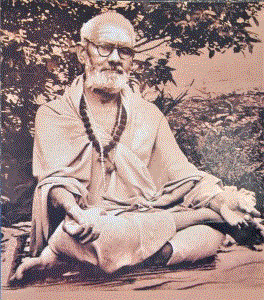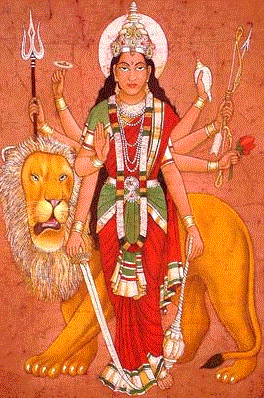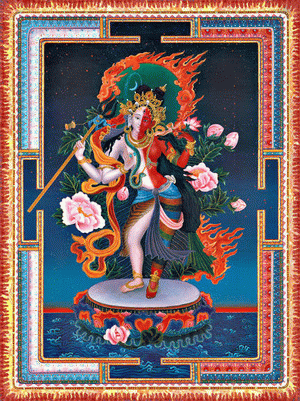Shakti (Kundalini) Divine Power. by Swami Vishnu Tirtha
Maharaj, with Forward by Mahamahopadhyaya Gopinath Kaviraj,
J.A., Formerly Principal, Government Sanksrit College,
Varanasi,1962

His
Holiness Shree Swami Vishnu
Tirtha

Chapter 11
Superiority of
Mahayoga
There are two ways of communion with
God. Ordinarily a person of ordinary understanding tries to
imagine of God as some super-man with a body residing in
heavens, supervising and governing the affairs of the world
from a distance, and according to his idea of God, he tries
to meditate on Him in prayer. This is in fact no communion
with Him, though it also helps hint spiritually to some
extent. Others who have their power of understanding
philosophically developed, try to fix their minds on Him as
a negation of the objective world. They try to keep their
minds vacant and free from all worldly thoughts thinking Him
as an all-pervading abstractness, theirs is an attempt to
come into communion with voidness. As is said in Srimad
Bhagwatam (9-9-49)
“He, That Brahman, who is most
subtle, and though not voidness is imaginable as voidness
(Shims), is regarded by Satwatas as the Lord
Vasudeva.”
That is the reason why Jain and
Buddhist philosophers went ultimately to the extreme point
of denying the very existence of God. To a Vedantin Brahman
is not voidness or an abstract negation. He is
Sat-Chit-Ananda—existence, consciousness and bliss
absolute, the triple oneness, Omnipresent existence
pervading everything as back-ground of all visible and
invisible objects, the ground on which all names and forms
of the objective creation appear moving. To have a mental
picture of such Brahman is also an impossibility and any
attempt in that direction is also thinking of an abstract
voidness.
The Upanishads declare that sight
cannot see Him, it is on His account that sight sees, ears
cannot hear Him, it is on His account that ears hear and so
is the case with every other sense. Mind too cannot think of
Him, it is on His account that mind thinks. How can one fix
one’s mind on Him ? There is therefore another way suggested
for coming into communion with Him, and it is through fixing
the mind on one’s own abstract conscious self because that
is also but a manifestation of the Absolute consciousness of
Brahman. But this method though better than others is in no
way so easy of practice as it apparently looks. All except
the last are negative forms of communion and as such are
included in Abhava yoga, which is defined as
follows.
Voidness altogether invisible
when meditated upon, it is called, Abhava Yoga, whereby one
sees the Self.
But when a person gets his mind
overflowing with blissful Peace and feels the tide of Ananda
saturating the very core of his heart and feels therein the
presence of never-abating divine intoxication, he is then in
fact in direct touch with God. Who is an embodiment of Bliss
itself. Such an experience is tangible, emotional and
inspiring.
When Kundalini awakens, She
spiritualizes the body and mind as if the divine influence
of God has descended on the physical plane. Such influence
varies in intensity with different persons and in particular
individuals too its flow of intensity fluctuates from time
to time. It is said of Chaitanaya Mandprabhu, also known as
Lord Gouringa of Bengal, that at times he used to be in such
a high stage of divine influence that rays of light used to
radiate from his body. In recent years a young man came in
contact with the author who claimed that at times when he
meditated upon his own self as Brahman, a sensation of
electric-like current within his body was felt by him and
sparks of light resembling electric sparks were seen
shooting out of his body. The experience filled him no doubt
with great pleasure and was elevating.
When the power of Kundalini awakens,
the whole of the person from the physical plane upwards
becomes changed and spiritualized. He begins to feel the
divine influence over his body, mind and intellect all
hours. He begins to feel the divine presence in himself at
all hours. To such a person the divine existence is not
something negative and abstract, not merely an idea, but a
positive reality. He drinks deep of the divine cup and
remains for all hours under divine intoxication. Such
communion with God is the communion surpassing all others
and is, therefore, named Mahayoga.
” When a person sees Me (God) the
dimless and ever blissfull identical with himself, that is
called Mahayoga, itself the highest. Yoga is thus known of
two kinds, verily the first is regarded as Abhava or
negative yoga and the other as Maha-yoga the best of all
systems.”
It has already been told that
awakening of Kundalini gives a start to the upward march of
self evolution, through uncoiling or unfoldment of the
involutionary process which has, so to speak, woven sheaths
upon sheaths of cocoon-like coils encaging the self within
its manifold coverings and ultimately culminates the
evolutionary process in complete disentanglement of the self
to the degree of its own divine self effulgence, though in
fact never marred in the least. When the uncoiling of
Kundalini once starts the involution that has been the work
of beginningless ages, is soon undone. Brahmin, the ever
free cause of the universe, is in fact never involved within
the bounds of maya and is the master of His Shakti, who
appears as formally different from Him The work of Shakti is
but an impulse of the Lord Himself, therefore those persons
who resign themselves utterly to His lotus feet soon become
favoured with His ever shining presence.
As a minute spark of fire may burn
heaps of straw in no time and the ensuing big conflagration
is not different from the original spark, so the divine
spark of the awakened Kundalini is the Lord Himself. When
the whole heap of straw has been consumed, the fire
extinguishes into voidness. Burning of straw is but the
manifestation of heat lying involved in it through its
involutionary process. All the fire that appeared from
combustion was simply lying hidden in the form of straws, or
as if the fire itself had assumed the form of
straws.
Ignition once, started soon uncoils
the whole amount of heat stored up there and sends the whole
heap into flames. Similarly when a master throws sparks of
divine fire, it ignites and sets the involved Kundalini to
flames, which soon takes up the form of a big fire – the
Lord on the physical plane. A Yogi calls Him the self of his
self, but when all straws have been burnt, like the
extinguished fire, the Kundalini power also merges into the
Absolute. One has simply to raise one’s self to the ignition
point. All other preparations in the form of piety, virtuous
deeds, devotion to God, and prayers or other methods of
invoking God, improve our combustibility in that respect
that the slightest touch or contact with spiritual persons
may light in us the divine fire instantaneously.
Mere thinking of the Absolute and
trying to get hold of the unapproachable and, grasping the
abstract and bringing in within the bounds of mind which
transcends both mind and senses are above described as
Abhava yoga, a yoga of negation ; whereas realization of the
conflagration of the divine fire within one’s own self is
called Mayayoga.
After Kundalini has merged, into the
Absolute, the physical body and mind consumed to
purification by the awakened divine fire that has now gone
out and disappeared into Shiva bear the look of a cover of
the residual ashes besmearing the body of Shiva. It is
believed that Shiva smears Himself with the ashes of a burnt
corpse, which symbolizes the body of a liberated person, a
Jivan Mukta, i.e., a soul whose bondage of Maya has been
consumed.

Table of Contents


Buy Devatma
Shakti on Amazon

